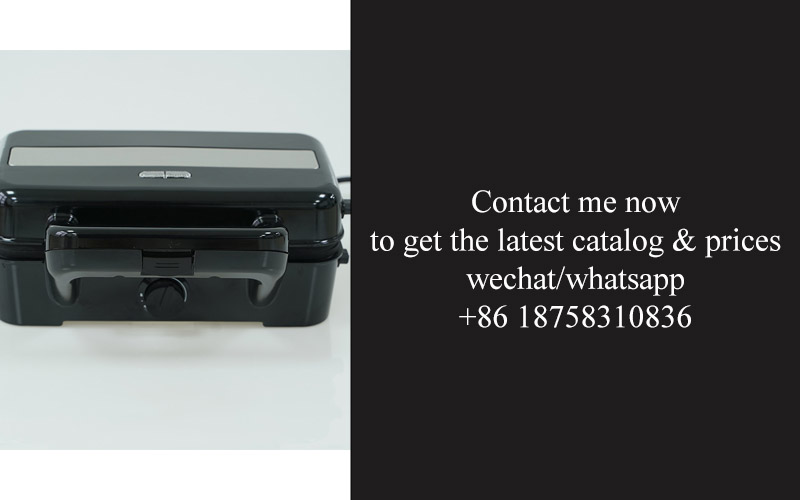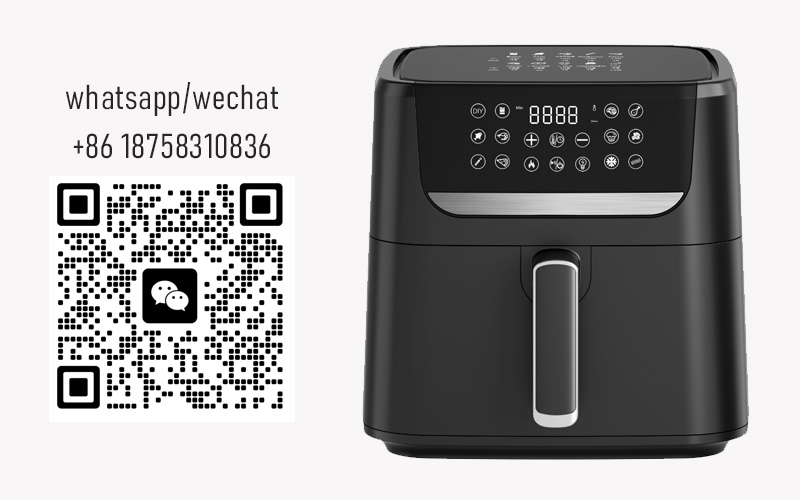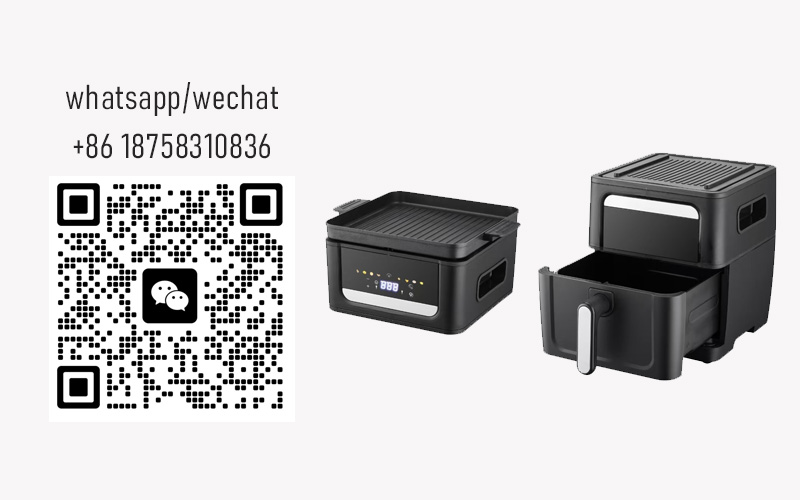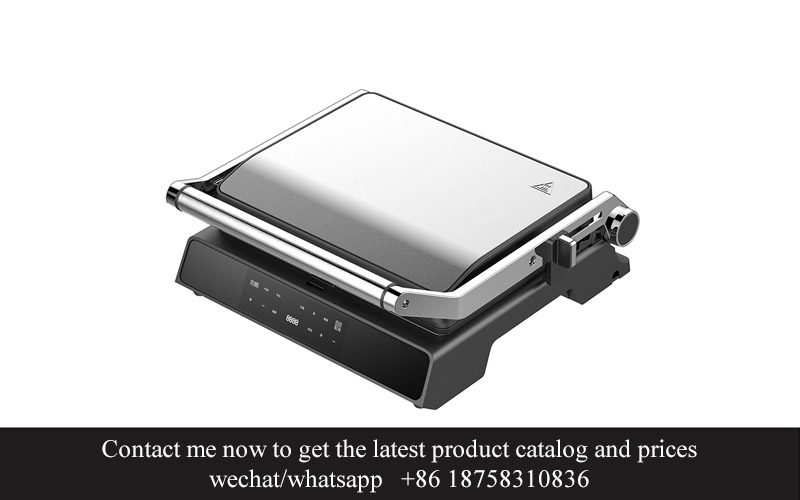Address
304 North Cardinal
St. Dorchester Center, MA 02124
Work Hours
Monday to Friday: 7AM - 7PM
Weekend: 10AM - 5PM
Address
304 North Cardinal
St. Dorchester Center, MA 02124
Work Hours
Monday to Friday: 7AM - 7PM
Weekend: 10AM - 5PM

As the culinary landscape continues to evolve, the kitchen has become a hotbed of innovation, with technology playing a pivotal role in shaping our cooking experiences. Among the latest advancements, restaurant-grade air fryers have emerged as a game-changer, bringing the flavors of professional kitchens into the comfort of our own homes. This shift not only promises to revolutionize the way we cook but also opens up a world of health benefits and convenience. Let’s delve into the science, the journey, the unique features, and the future trends that define the rise of restaurant-grade air fryers in the modern kitchen.
The culinary landscape is undergoing a delightful transformation, with the rise of restaurant-grade air fryer factories emerging as a game-changer for home cooks. These factories are not just producing air fryers; they are crafting appliances that bridge the gap between professional-grade cooking and the comfort of home cooking. Let’s dive into the reasons behind this surge and how it’s reshaping the way we cook.
In recent years, there’s been a noticeable shift in the home kitchen, with air fryers becoming a staple in many households. However, the new wave of restaurant-grade air fryers takes this convenience to another level. These aren’t your average countertop appliances; they are designed to deliver restaurant-quality results right in your own kitchen.
These factories are at the forefront of innovation, focusing on creating air fryers that can handle the demands of high-volume cooking. The technology inside these machines is sophisticated, featuring advanced heating elements and precise temperature controls that mimic the professional standards found in commercial kitchens.
The allure of restaurant-grade air fryers lies in their ability to replicate the crispy, golden texture of fried foods without the added guilt. By using hot air to circulate around the food, these appliances reduce the need for excessive oil, making them a healthier option. This health-conscious approach is resonating with consumers who are looking for ways to indulge in their favorite fried treats without compromising on taste or health.
One of the standout features of these air fryers is their versatility. They can cook a wide array of dishes, from crispy French fries to juicy chicken wings, all with minimal oil. This versatility is a game-changer for home cooks who want to experiment with different recipes without the hassle of multiple cooking appliances.
The design of these air fryers is also a testament to the commitment of these factories to quality. They are often made with durable materials that can withstand frequent use and the occasional drop. The sleek, modern look also makes them a stylish addition to any kitchen, blending in with contemporary decor.
The process of manufacturing these air fryers is a blend of technology and craftsmanship. From the initial design phase to the final quality checks, each step is carefully monitored to ensure that the end product meets the high standards expected from restaurant-grade appliances. The factories invest in state-of-the-art machinery to achieve precision in every detail.
As these factories expand their operations, they are also contributing to the growth of the global kitchen appliance market. The demand for professional-grade appliances in residential settings is on the rise, and these factories are capitalizing on this trend. They are not just meeting the current needs but also setting the stage for future innovations in the kitchen.
Another key aspect of these factories is their focus on sustainability. By reducing the amount of oil needed for cooking, these air fryers help to minimize waste and environmental impact. The energy-efficient design of these appliances also contributes to lower utility bills for consumers, making them a more cost-effective choice in the long run.
Consumers are taking notice, and the positive feedback is overwhelming. Testimonials from home cooks who have adopted restaurant-grade air fryers speak volumes about the impact these appliances have had on their cooking experiences. The ease of use, the health benefits, and the incredible results are just a few of the reasons why these air fryers are becoming a favorite among food enthusiasts.
In conclusion, the rise of restaurant-grade air fryer factories marks a significant milestone in the evolution of home cooking. These factories are not just producing appliances; they are revolutionizing the way we approach cooking at home. With their focus on innovation, health, sustainability, and versatility, these air fryers are set to become a staple in kitchens around the world.

The kitchen appliances industry has always been a hotbed of innovation, constantly evolving to meet the changing demands of consumers. Now, a new wave of air fryers is making waves, offering a blend of convenience, health, and culinary versatility that’s redefining the way we cook at home. These aren’t your average countertop gadgets; these are the latest in kitchen technology, designed with the precision and performance of restaurant-grade equipment.
These modern air fryers are engineering marvels, equipped with advanced features that mimic the cooking techniques used in professional kitchens. They utilize rapid air technology to circulate hot air around food, creating a crispy outer layer while retaining moisture and nutrients inside. This process significantly reduces the amount of oil needed, making them a healthier alternative to traditional deep frying.
The user interface on these new air fryers is another standout feature. Many come with intuitive touch screens or digital displays that allow for precise temperature and time control. Users can choose from a variety of pre-programmed settings for everything from chicken wings to French fries, ensuring consistent results every time. For those who like to experiment, manual settings offer the freedom to adjust the cooking parameters to their liking.
One of the most remarkable aspects of this new wave of air fryers is their versatility. They can not only fry but also bake, roast, and even dehydrate. This means you can use a single appliance to prepare a wide range of dishes, from a crispy, golden-brown pizza to a tender, juicy roast chicken. The ability to switch between cooking modes with a simple button press is a game-changer for anyone looking to streamline their kitchen routine.
Durability is also a key factor in the design of these air fryers. With high-quality materials and robust construction, they are built to last. The exterior is often made of stainless steel or a similar material that not only looks sleek but also withstands the heat and oils of cooking. The interior, typically made of non-stick surfaces, makes for easy cleaning and maintenance.
Safety features have been meticulously engineered into these appliances as well. Many come with automatic shut-off functions that turn off the unit if it’s left unattended or if the air fryer is overheated. Some models even include a child lock to prevent accidental use, making them a safer choice for families.
The technology behind these air fryers is impressive. They often come with features like a convection fan that ensures even heat distribution, which is crucial for achieving that perfect crispiness. Some models also include a defrost setting, which is particularly handy for those mornings when you’re in a rush and need to cook frozen food without thawing it first.
The rise of these innovative air fryers has not only changed the way we cook at home but also influenced the food industry. Chefs and restaurateurs are embracing these appliances for their ability to produce high-quality, low-fat fried foods in a commercial setting. This trend is likely to influence the way we view and consume fried foods in the future.
Consumers are also taking notice. The health benefits of air frying, such as reduced oil and calorie content, are a major draw. With the increasing awareness of heart-healthy eating, these air fryers are becoming a staple in many kitchens. They’re not just for the health-conscious, either; the ease of use and ability to create restaurant-quality dishes at home have made them popular among food enthusiasts and busy professionals alike.
In conclusion, the new wave of air fryers is a testament to the power of innovation in kitchen appliances. With their advanced technology, versatility, and health benefits, these appliances are more than just a new trend; they’re shaping the future of home cooking. As these restaurant-grade air fryers continue to evolve, we can expect even more features and functionalities that will further enhance our culinary experiences.

The allure of restaurant-grade air fryers in the kitchen is undeniable. These appliances are not just trendy gadgets; they are a game-changer that’s reshaping how we approach cooking at home. Here’s why they’re becoming the next big thing:
These fryers mimic the professional quality found in top-tier restaurants, offering home cooks the ability to achieve that same crispiness and flavor without the deep-fat frying. The technology has advanced to a point where the taste and texture of food cooked in these units are often indistinguishable from those cooked in traditional fryers, but with significantly reduced oil content.
Gone are the days when air frying was synonymous with a compromise on taste. Modern restaurant-grade air fryers use rapid air circulation to create a frying effect, reducing the need for excess oil by as much as 80%. This not only makes meals healthier but also less greasy, appealing to health-conscious consumers who still want to enjoy fried foods.
The versatility of these air fryers is unparalleled. They can perform a variety of cooking tasks beyond just frying, such as roasting, baking, and even dehydrating. This multifunctionality means that one appliance can replace several in your kitchen, streamlining your cooking process and reducing clutter.
One of the standout features of restaurant-grade air fryers is their precise temperature control. This level of accuracy ensures that every dish is cooked to perfection, from golden-brown crispy French fries to tender yet caramelized chicken wings. The ability to adjust temperatures and cooking times allows for greater control over the final outcome of your meals.
The compact design of these air fryers is a significant advantage for kitchen space. Unlike traditional deep fryers that can take up a considerable amount of counter space, these units are sleek and can often be tucked away on a countertop or in a cabinet. This space-saving feature is particularly appealing for those with smaller kitchens or those who prefer a more minimalist aesthetic.
The convenience factor cannot be overstated. With a simple push of a button, you can set the desired temperature and cooking time, and let the air fryer do the work. This hands-off approach is perfect for busy individuals who want to enjoy restaurant-quality meals without the hassle of standing over a hot stove.
Safety is another area where restaurant-grade air fryers excel. They operate at a lower temperature than deep fryers, reducing the risk of grease fires and kitchen accidents. Additionally, many models come with features like automatic shut-off and cool-touch exteriors, making them a safer option for families with young children.
In terms of maintenance, these air fryers are a breeze to clean. The non-stick interiors and removable parts make it easy to wipe down or rinse after use, saving time and effort. This ease of cleaning contributes to the appliance’s overall appeal, especially for those who are short on time or prefer to spend their evenings relaxing rather than cleaning up.
The integration of smart technology is also a notable aspect of these air fryers. Many models now come with Bluetooth capabilities or companion apps that allow users to control the appliance remotely, track cooking progress, and even receive recipes and cooking tips. This level of connectivity enhances the user experience and adds a layer of personalization to the cooking process.
Finally, the environmental impact of these air fryers is a compelling reason for their growing popularity. By using less oil and providing a more energy-efficient cooking method, these appliances contribute to a reduced carbon footprint and support sustainable living practices.
In summary, the rise of restaurant-grade air fryers in the kitchen is a testament to innovation and consumer demand. Their ability to deliver restaurant-quality results with health benefits, versatility, and convenience is what makes them the next big thing in culinary appliances. Whether you’re a seasoned chef or a weekend warrior in the kitchen, these fryers are poised to change the way we cook and enjoy our meals.

The science behind the scenes of restaurant-grade air fryers is a blend of advanced technology and clever engineering that transforms cooking into an efficient and healthier process. These appliances have revolutionized the way we cook by leveraging principles from thermodynamics, food science, and material science.
Air fryers utilize the science of convection to cook food. Unlike traditional frying, which submerges food in hot oil, air fryers use hot air to circulate around the food, creating a crispy outer layer while reducing the amount of oil needed by up to 80%. This process is often referred to as “frying” but is more accurately a form of low-oil or oil-free cooking.
The key to this technology lies in the fan and heating element within the air fryer. As the fan spins, it forces the hot air to circulate rapidly around the food, ensuring an even cooking temperature from all angles. The heat is typically produced by an electric element, which can reach temperatures high enough to achieve that coveted crispy texture on the outside without burning the inside.
The science of food texture is also pivotal in understanding how air fryers work. The high temperature causes the outer surface of the food to harden, creating a crust. As the temperature drops, moisture inside the food tries to escape, but because of the crust’s resistance, the steam turns into a fine mist, which evaporates quickly, leading to a tender and moist interior.
Material science plays a role in the efficiency of these appliances as well. The exterior is often made from a durable material that can withstand high temperatures, and the interior is coated with a non-stick surface that not only makes cleaning easier but also ensures even heat distribution.
Moreover, the design of restaurant-grade air fryers includes precise temperature controls and timers, which are crucial for achieving consistent results. By allowing the user to adjust the temperature and cooking time, these appliances empower cooks to experiment with various recipes and cooking techniques.
The science behind these appliances doesn’t just stop at the physical aspect. Food science also plays a part in the nutritional aspect. Because air fryers use less oil, they are a healthier alternative for those looking to reduce their fat intake. The reduction in oil also means that the food is lower in calories, making it a more diet-friendly option.
One of the most innovative aspects of air fryers is their versatility. They can handle a wide range of foods, from chicken and fish to vegetables and even desserts. The science behind these appliances allows them to be used for baking, roasting, and even defrosting, which is a significant departure from traditional frying methods.
The evolution of restaurant-grade air fryers also involves energy efficiency. These appliances are designed to use less electricity than conventional ovens and fryers, which not only saves money on energy bills but also reduces the carbon footprint.
The science behind these appliances doesn’t just make them a game-changer in the kitchen; it also fosters a deeper understanding of the food we eat and the way we prepare it. It’s a testament to the power of combining scientific knowledge with everyday kitchen appliances to improve our lives.
The air fryer’s ability to mimic the textures and flavors of fried food without the unhealthy fats is nothing short of miraculous. It’s this fusion of science and technology that has made restaurant-grade air fryers the next big thing in the kitchen. From the home cook to the professional chef, these appliances are changing the way we perceive cooking and the health implications that come with it.

In the world of kitchen appliances, the transition from a factory floor to the kitchen counter is a journey marked by precision, innovation, and a deep understanding of consumer needs. Restaurant-grade air fryers, in particular, embody this journey with their seamless blend of technology and culinary convenience. Let’s take a closer look at how these appliances come to life and find their way into our homes.
The Design Process begins with a vision. Engineers and designers work in collaboration, considering the latest in air fryer technology, ergonomics, and user experience. They sketch out concepts that will eventually turn into prototypes, each iteration refined to meet the exacting standards required for a product that will withstand the rigors of commercial kitchens.
Once the design is finalized, it moves to the prototype stage. Molding and assembly teams carefully craft the first samples, ensuring every part fits perfectly. The prototypes are then rigorously tested for functionality, safety, and durability. It’s a meticulous process that often involves a series of “trial and error” cycles until the design meets the stringent requirements for a restaurant-grade product.
Next, the production line comes into play. Factory workers, many with years of experience in appliance manufacturing, begin the mass production process. They assemble the air fryers with precision, following strict quality control measures to ensure each unit is up to par. Automation is a key factor here, but human oversight remains crucial to catch any defects before the product moves on to the next phase.
The components of these air fryers are sourced from reputable suppliers, each selected for their commitment to quality and reliability. High-grade materials like stainless steel and durable plastics are used to construct these appliances, making them not just durable, but also capable of handling the demands of continuous use in commercial settings.
After assembly, the air fryers undergo a series of tests. These include thermal testing to ensure even heating, electrical safety tests, and endurance tests to check how long the appliances can run without failing. These tests are not just about passing regulations; they’re about ensuring that the end-user will have a long-lasting, safe, and efficient appliance.
Quality control is paramount in the world of restaurant-grade appliances. Products are inspected multiple times throughout the production process. Workers use magnifying glasses to inspect for even the smallest defects. Any unit that fails to meet the quality standards is immediately flagged and either sent back for reassembly or discarded.
Once a product passes all inspections, it’s ready for packaging. Careful consideration is given to packaging materials and design to protect the appliance during transit and ensure that the customer can easily unpack and store it. Packaging also includes user manuals and safety warnings, ensuring that the customer has all the information needed to use the air fryer safely.
The journey of the air fryer from factory to kitchen counter is often a long one. It involves logistics, distribution, and transportation. The appliance might be shipped from the factory to a distribution center, then to a retailer, and finally to the customer’s doorstep. Each step is managed to minimize handling and ensure the product arrives in perfect condition.
Upon arrival, the customer is met with a sleek, well-packaged air fryer, ready to transform their home kitchen into a hub of culinary exploration. The journey of the restaurant-grade air fryer is not just about the physical movement from one place to another; it’s about the journey from a mere idea to a powerful tool that can revolutionize the way people cook at home.
In summary, the transformation of an air fryer from the factory floor to the kitchen counter is a story of craftsmanship, innovation, and unwavering quality standards. It’s a testament to the dedication of those who work tirelessly to bring us the latest advancements in kitchen appliances, making our lives easier and more enjoyable in the process.

The advanced technology and design of restaurant-grade air fryers have transformed the way we approach cooking at home. These appliances, originally designed for commercial kitchens, have now found their way into our homes, offering a blend of convenience, health benefits, and culinary versatility. Here are some of the key features that set these air fryers apart from their home counterparts:
Commercial-Grade Durability: Restaurant-grade air fryers are built to withstand the rigorous demands of professional kitchens. Their sturdy construction, often featuring stainless steel bodies and reinforced components, ensures they can handle constant use without compromising performance or safety.
Superior Heat Distribution: These air fryers utilize a fan-assisted system to circulate hot air around the food, ensuring even cooking and a crispy texture. The precise heat distribution prevents cold spots and overcooking, which is a common issue in traditional home air fryers.
Large Capacity: With sizes ranging from 3 to 6 quarts, restaurant-grade air fryers can accommodate larger batches of food. This makes them ideal for families or anyone hosting gatherings, as they can cook for more people without the need for multiple appliances.
Programmable Settings: Many restaurant-grade models come with a variety of pre-programmed settings tailored to different types of food, such as chicken, fish, vegetables, and even desserts. These settings not only simplify the cooking process but also ensure optimal results every time.
Higher Temperature Range: While most home air fryers operate at temperatures up to 400°F (204°C), restaurant-grade models can reach much higher temperatures, sometimes exceeding 500°F (260°C). This elevated heat allows for faster cooking times and the ability to sear or brown food to perfection.
Digital Control Panels: The digital interfaces on restaurant-grade air fryers offer precise control over cooking times and temperatures. This level of accuracy is crucial for achieving the desired texture and taste, especially when preparing complex dishes.
Safety Features: Safety is paramount in commercial kitchens, and restaurant-grade air fryers reflect this with their range of safety features. These include overheat protection, automatic shut-off mechanisms, and cool-touch exteriors to prevent accidental burns.
Energy Efficiency: Despite their commercial roots, these air fryers are designed to be energy-efficient. The high-speed fan and even heat distribution minimize cooking times, which in turn reduces energy consumption.
Easy Cleaning: Many models are designed with removable parts that are dishwasher-safe, making cleaning up after cooking a breeze. The non-stick interiors also help to prevent food from sticking, further simplifying the cleaning process.
Quiet Operation: While commercial kitchens are often noisy environments, restaurant-grade air fryers are engineered to operate quietly, ensuring a peaceful cooking experience at home.
Customizable Baskets: The baskets that come with these air fryers are often customizable, with sizes and shapes that cater to various types of cooking. Some models even offer adjustable basket heights for different foods.
Versatility: Restaurant-grade air fryers are not just for fried foods. They can be used for roasting, baking, and even dehydrating, making them a versatile tool for a wide range of culinary applications.
Brand Reputation: Many restaurant-grade air fryers come from well-known brands with a strong reputation for quality and durability. This brand trust is important for home cooks looking for appliances that will last and deliver consistent results.
In summary, the key features of restaurant-grade air fryers are what set them apart from traditional home appliances. Their durability, precision, and versatility make them an invaluable addition to any kitchen, whether for the casual home chef or the seasoned professional.

In the realm of kitchen appliances, air fryers have long been a favorite for their ability to create crispy, flavorful food with minimal oil. However, it’s the rise of restaurant-grade air fryers that’s truly shaking things up. These high-performance appliances are not just for home chefs looking to mimic professional results; they’re changing the game entirely. Here’s what sets them apart, and why they’re becoming a staple in kitchens everywhere.
The ability to achieve restaurant-quality results at home is a game-changer. These air fryers are designed to mimic the commercial-grade appliances found in professional kitchens. They boast powerful heating elements and precise temperature controls, ensuring that every dish is cooked to perfection. From crispy fries to tender chicken, the outcome is consistently impressive.
One of the standout features of restaurant-grade air fryers is their large capacity. These units are significantly larger than their consumer counterparts, allowing for the cooking of larger batches of food. This is particularly beneficial for families or those entertaining guests, as it eliminates the need for multiple batches and ensures that everyone gets their fair share of delicious, crispy treats.
Efficiency is another key factor. These air fryers are designed to use less oil than traditional deep-frying methods, but they still deliver that coveted crispy texture. The secret lies in the air circulation technology, which circulates hot air around the food, creating a crispy outer layer while keeping the interior moist and tender. This not only reduces the fat content but also cuts down on cooking time and energy usage.
The versatility of restaurant-grade air fryers is unparalleled. They can handle a wide range of cooking methods, from frying to roasting, baking, and even dehydrating. This means you can use the same appliance to cook a variety of dishes, from savory chicken wings to sweet apple slices. The ability to switch between these modes with a simple button press or temperature adjustment is incredibly convenient and time-saving.
Safety features are also a priority in these high-end appliances. Many come with automatic shut-off functions that activate if the unit is left unattended or if the temperature exceeds safe levels. This not only prevents accidents but also gives users peace of mind, knowing that their kitchen is safe from potential hazards.
The build quality of restaurant-grade air fryers is exceptional. They are often constructed with durable materials like stainless steel, which not only looks sleek and modern but also withstands the rigors of frequent use. The non-stick surfaces inside the fryer basket make cleaning a breeze, ensuring that your appliance stays in top condition for years to come.
In terms of design, these air fryers are sleek and modern, fitting seamlessly into any kitchen decor. The intuitive interfaces with digital displays and programmable settings make them user-friendly for everyone from the novice cook to the seasoned chef. The ability to set specific cooking times and temperatures ensures that even complex recipes can be executed with ease.
Another advantage is the noise level. While all air fryers produce some noise, restaurant-grade models are designed to be quieter than their consumer counterparts. This is especially important for those who enjoy cooking but don’t want to be disturbed by a loud appliance.
The health benefits of air frying are undeniable. By using less oil, these appliances help reduce the calorie and fat content of fried foods, making them a healthier option. This is particularly appealing to health-conscious consumers who still want to enjoy their favorite crispy dishes without the guilt.
The environmental impact of cooking methods is also a growing concern. Restaurant-grade air fryers are more energy-efficient than traditional deep-frying methods, which not only saves money on energy bills but also reduces the carbon footprint. This eco-friendly aspect is a significant draw for environmentally conscious consumers.
Lastly, the cost of these appliances can be a deterrent for some. However, when you consider the long-term savings on energy and the reduction in the need for additional kitchen appliances, the investment can be justified. Plus, the convenience and health benefits make them a worthwhile purchase for anyone looking to elevate their home cooking experience.
In conclusion, the key features that set restaurant-grade air fryers apart are their ability to deliver restaurant-quality results, large capacity, efficiency, versatility, safety, build quality, design, noise level, health benefits, and environmental impact. These features make them a standout choice for anyone looking to take their home cooking to the next level.

In the culinary world, the demand for professional-grade kitchen appliances has been on the rise, and this trend is no exception when it comes to restaurant-grade air fryers. The market analysis of this niche sector reveals several key factors contributing to its growing popularity among both commercial chefs and home cooks alike.
The Shift Towards Healthier Cooking MethodsConsumers are increasingly health-conscious, seeking out cooking techniques that offer healthier alternatives to traditional frying. Restaurant-grade air fryers provide a solution that locks in flavors while using less oil, appealing to those looking to reduce their fat intake. This shift towards healthier eating habits is a driving force behind the growing demand for these appliances.
The Influence of Food Culture and Cuisine EvolutionFood culture is constantly evolving, and with it, the tools used to prepare dishes. As chefs experiment with global flavors and techniques, the need for high-quality appliances that can replicate or enhance these culinary experiences becomes apparent. Restaurant-grade air fryers can mimic the texture and taste of deep-fried foods without the drawbacks, making them a staple in kitchens worldwide.
Technological Advancements and AccessibilityThe development of new technologies has made professional-grade appliances more accessible to the average consumer. With advancements in design and efficiency, restaurant-grade air fryers are now compact and user-friendly, bridging the gap between home and commercial kitchens. This accessibility has democratized professional-grade equipment, allowing more home cooks to enjoy the benefits of these advanced appliances.
E-commerce and Global DistributionThe rise of e-commerce platforms has significantly expanded the reach of restaurant-grade air fryers. Online retailers can distribute these products globally, making them available to a wider audience. This accessibility has spurred an increase in consumer awareness and has been instrumental in the rapid growth of the market.
Economic Factors and Cost-EffectivenessEconomic factors such as the cost of living and the rising prices of food ingredients have also influenced the demand for professional-grade appliances. Restaurant-grade air fryers can be a cost-effective solution for both businesses and individuals looking to minimize their expenses while still achieving high-quality results. Their energy efficiency also contributes to long-term savings.
Health Regulations and CertificationIn some regions, health regulations are tightening, requiring restaurants to adhere to more stringent guidelines regarding cooking methods and food safety. Restaurant-grade air fryers offer a healthier cooking alternative that can help establishments meet these new standards. The availability of these appliances often comes with certifications that validate their safety and health benefits, further bolstering consumer confidence.
Sustainability and Environmental ConcernsSustainability is a growing concern for consumers and businesses. Restaurant-grade air fryers consume less oil and energy than traditional frying methods, making them a more environmentally friendly choice. As awareness of environmental issues increases, the demand for sustainable appliances is likely to continue growing.
Competitive Pricing and InnovationCompetitive pricing and continuous innovation in the appliance industry have also played a role in the increased demand for professional-grade kitchen appliances. Manufacturers are constantly seeking to improve their products, offering new features and benefits that appeal to both the professional and the home cook. This competition has driven down prices and made these appliances more affordable.
The rise in demand for professional-grade kitchen appliances, particularly restaurant-grade air fryers, is a multifaceted phenomenon. It reflects changing consumer preferences, technological advancements, economic considerations, and broader social and environmental trends. As these factors continue to evolve, the market for restaurant-grade air fryers is poised to grow even further, transforming the way we cook and eat.

In today’s fast-paced culinary landscape, the demand for high-quality, professional-grade kitchen appliances has surged. When it comes to air fryers, finding the right restaurant-grade model can be a game-changer for both home chefs and commercial kitchens alike. Here are some key factors to consider when selecting the perfect restaurant-grade air fryer factory.
The first aspect to examine is the reputation of the factory. Look for manufacturers with a solid track record in the industry, known for their commitment to quality and innovation. A factory with years of experience and a history of satisfied customers is more likely to produce a reliable and durable product.
Quality of MaterialsThe materials used in the construction of a restaurant-grade air fryer are crucial. High-quality stainless steel and durable plastics are preferred for their longevity and resistance to wear and tear. A factory that prioritizes these materials ensures that the air fryer can withstand the rigors of commercial use.
Safety StandardsSafety should always be a top priority. A reputable factory adheres to stringent safety standards, ensuring that their air fryers meet or exceed industry regulations. Look for certifications such as CE, UL, or ETL, which guarantee that the appliance is safe for use in both residential and commercial settings.
Cooking CapacityThe capacity of the air fryer is an important consideration, especially for commercial kitchens. A larger capacity allows for cooking larger batches of food, which is essential for high-volume operations. Be sure to choose a factory that offers a range of sizes to accommodate different kitchen needs.
Energy EfficiencyEnergy efficiency is not just a concern for the environment; it also affects your utility bills. A restaurant-grade air fryer that consumes less energy can lead to significant cost savings over time. Opt for a factory that focuses on energy-efficient designs and technologies.
Ease of UseEven in a busy kitchen, the air fryer should be easy to use. Look for features like intuitive controls, digital displays, and programmable settings that simplify the cooking process. A factory that understands the needs of professional chefs will design air fryers with user-friendliness in mind.
Warranty and Customer ServiceA reliable warranty and excellent customer service are indicators of a factory’s confidence in their product. A comprehensive warranty can provide peace of mind, knowing that the factory stands behind the quality of their air fryers. Additionally, responsive customer service is essential for any kitchen, as issues may arise from time to time.
Customization OptionsFor those with specific kitchen requirements, customization can be a valuable feature. Some factories offer the ability to tailor their air fryers to meet unique needs, such as adjustable temperature controls or specialized cooking functions. This level of customization can be a significant advantage in creating the perfect kitchen setup.
Innovation and TechnologyA forward-thinking factory invests in research and development to bring cutting-edge technology to their air fryers. Features like smart technology integration, advanced heating elements, and unique cooking modes can set a factory’s products apart from the competition.
Durability and LongevityThe longevity of an air fryer is determined by its construction and the quality of its components. A factory that values durability will use robust designs and high-quality parts, ensuring that the air fryer remains a reliable tool for years to come.
After-Sales SupportBeyond the warranty, the level of after-sales support offered by a factory can greatly impact the overall experience. This includes everything from installation assistance to troubleshooting and maintenance tips. A factory that provides comprehensive after-sales support demonstrates a commitment to customer satisfaction.
In conclusion, selecting the right restaurant-grade air fryer factory involves a careful evaluation of several key features. From reputation and safety standards to cooking capacity and energy efficiency, each aspect plays a role in determining the suitability of the air fryer for your kitchen. By considering these factors, you can make an informed decision that will serve your culinary needs for years to come.

In today’s eco-conscious world, the quest for sustainability and energy efficiency has become a cornerstone of innovation, especially in the realm of kitchen appliances. Factory innovations in sustainability and energy efficiency are not just trends; they are pivotal in shaping the future of consumer benefits. Let’s delve into how these advancements are making a tangible difference.
The Shift Towards Eco-Friendly MaterialsManufacturers are increasingly adopting eco-friendly materials in the production of restaurant-grade air fryers. These materials are not only durable but also designed to minimize environmental impact. Recycled plastics, stainless steel, and aluminum alloys that require less energy to produce are becoming the norm, reducing the carbon footprint of these appliances.
Energy Efficiency in DesignThe heart of any air fryer lies in its ability to cook with minimal energy use. Modern restaurant-grade air fryers are engineered with advanced heating elements and insulation that ensure heat is contained efficiently, reducing energy consumption. This design not only slashes utility bills but also lessens the appliance’s overall environmental impact.
Smart Cooking TechnologyIntegrating smart technology into air fryers has not only made cooking more convenient but also more sustainable. These smart appliances can optimize cooking times and temperatures, ensuring that food is cooked efficiently without any unnecessary energy waste. Users can remotely control their appliances through apps, which means they can start cooking before they even arrive home, saving energy and time.
Heat Recovery SystemsInnovative factories are implementing heat recovery systems that capture and reuse heat generated during the cooking process. This not only reduces energy consumption but also helps in reducing the appliance’s operating temperature, which in turn extends the lifespan of the appliance and makes it safer to use.
Energy Star RatingsMany restaurant-grade air fryers now come with Energy Star ratings, which signify that they meet strict energy efficiency guidelines set by the U.S. Environmental Protection Agency (EPA). These ratings are a clear indicator to consumers that the appliance is designed to save energy without compromising performance.
The Importance of Lifecycle AnalysisFactories are now conducting lifecycle analyses to understand the total environmental impact of their products. This includes the production, use, and disposal stages. By identifying areas where energy can be saved or emissions reduced, manufacturers can make informed decisions that lead to more sustainable products.
Waste Reduction in ProductionEfficiency in production processes is crucial for sustainability. Factories are finding ways to reduce waste by optimizing manufacturing techniques, such as lean production and just-in-time inventory management. This not only cuts down on the energy used in production but also minimizes the waste that ends up in landfills.
Consumer Education and SupportAs awareness of sustainability grows, factories are investing in educational resources for consumers. This includes providing information on how to use the appliance efficiently and how to maintain it to ensure its longevity. By empowering consumers with knowledge, manufacturers encourage responsible usage and care for their products.
Innovative Disposal and Recycling ProgramsThe end of an appliance’s life cycle is a critical moment for sustainability. Factories are introducing innovative disposal and recycling programs that make it easier for consumers to recycle their old air fryers. Some even offer incentives for returning old appliances for recycling, further encouraging a circular economy.
In conclusion, the intersection of sustainability and energy efficiency in factory innovations is reshaping the landscape of consumer benefits. From eco-friendly materials to smart technology and lifecycle analysis, these advancements are not just about reducing energy consumption; they are about creating a more sustainable future for all. As consumers, we have the power to support these initiatives by choosing products that align with our values and by making informed decisions about how we use and dispose of our appliances.

The air fryer industry has seen a surge in popularity, and restaurant-grade air fryers have emerged as a favorite among both professional chefs and home cooks. These appliances are not just a trend; they represent a significant shift in how we approach cooking. Here are some real-life experiences and testimonials from consumers who have embraced the revolution brought by restaurant-grade air fryers.
Consumers have shared their experiences with these versatile kitchen gadgets, and the stories are as varied as the dishes they’ve prepared. One user raved about the ease of using a restaurant-grade air fryer for crispy fried chicken at home, noting that the results were surprisingly close to what you might find in a restaurant. Another customer praised the appliance for its ability to cook a variety of foods with minimal oil, making it a healthier alternative to traditional frying methods.
One testimonial highlighted the convenience of the air fryer, saying, “I was skeptical at first, but after trying it, I’m hooked. It’s so simple to use, and I love that I can cook a batch of fries or chicken wings without the guilt of deep-frying.” This sentiment was echoed by many others, who appreciated the ability to enjoy their favorite fried foods without the mess and high calorie count.
Many consumers have also shared their success with cooking vegetables using the air fryer. A common theme among these testimonials is the enhanced flavor and texture that the air fryer brings to roasted vegetables. One user commented, “I used to think that roasted veggies were bland, but the air fryer changed that. They come out crispy and full of flavor, and it’s so much healthier than boiling or steaming.”
One of the standout features of restaurant-grade air fryers is their ability to replicate the texture of deep-fried foods without the oil. This has been a game-changer for many who are health-conscious or have dietary restrictions. A user with dietary restrictions said, “The air fryer has been a lifesaver for me. I can enjoy crispy, satisfying snacks without the fear of going over my calorie or fat intake.”
The versatility of these air fryers has also been a major selling point. One customer noted, “I’ve used it for everything from chicken to fish to tofu, and it always delivers. The different temperature settings and timer functions make it easy to cook a wide range of dishes with precision.”
Several testimonials highlighted the durability and build quality of restaurant-grade air fryers. A user mentioned, “I’ve had mine for over a year now, and it’s still going strong. The non-stick coating is fantastic, and the appliance itself feels sturdy and well-made.” This sentiment was shared by many others, who found that their air fryers could handle the rigors of regular use without showing signs of wear.
Another common theme in consumer reviews is the positive impact that air fryers have had on their cooking routines. One user said, “I used to avoid making fried foods at home because of the mess and cleanup. Now, I can enjoy them whenever I want with minimal cleanup.” This convenience has been particularly appreciated by busy families and those who enjoy cooking but don’t want to spend hours in the kitchen.
The eco-friendly aspect of air fryers has also been celebrated. A consumer noted, “Not only does the air fryer help me eat healthier, but it’s also better for the environment because it uses less energy than traditional deep-frying methods.” This perspective resonates with many who are looking for ways to reduce their carbon footprint in the kitchen.
In the realm of customer service, testimonials have shown that manufacturers of restaurant-grade air fryers are often responsive to consumer needs. A user who had a minor issue with their appliance mentioned, “I contacted customer service, and they were incredibly helpful. They sent me a replacement part right away, and the whole process was seamless.”
The collective experiences shared by consumers paint a picture of a product that has truly transformed the way people cook at home. The ease of use, health benefits, and versatility of restaurant-grade air fryers have made them a staple in many kitchens. As more people discover the joys of air frying, the testimonials continue to grow, each one a testament to the positive impact these appliances have on daily life.

The air fryer industry is on the cusp of significant evolution, with trends that promise to reshape the way we cook and consume food. From technological advancements to shifts in consumer preferences, here’s a glimpse into what the future holds for the air fryer industry.
Innovation in TechnologyTechnological progress is a driving force behind the future of air fryers. Expect to see air fryers that are not only more efficient but also equipped with smart features. Imagine air fryers that can be controlled via smartphone apps, offering personalized cooking settings and even suggesting recipes based on the user’s dietary preferences and the ingredients on hand.
Health and Wellness IntegrationAs health consciousness grows, so does the demand for appliances that support healthier lifestyles. The future air fryer industry is likely to see a surge in models that are designed to reduce fat content in cooking without compromising on taste. Features like adjustable temperature controls and precise cooking times will allow for healthier versions of favorite fried foods.
Sustainability FocusWith environmental concerns at the forefront, the air fryer industry is poised to embrace sustainability. This could manifest in several ways, from the use of eco-friendly materials in manufacturing to energy-efficient designs that reduce the carbon footprint. Companies may also explore the use of renewable energy sources in their production processes.
Customization and PersonalizationPersonalization is becoming a key trend in consumer electronics, and air fryers are no exception. The future could bring air fryers that are customizable not just in terms of cooking settings but also in design. Users might be able to choose from various attachments or even design their own fryer to match their kitchen decor.
Cross-Functional AppliancesThe line between kitchen appliances is blurring, and air fryers are likely to become more versatile. Future models might incorporate features that allow them to double as dehydrators, slow cookers, or even sous-vide devices. This would make them a must-have for those who love to experiment with different cooking techniques.
Globalization of FlavorsAs people become more exposed to international cuisines, there’s a growing interest in replicating these flavors at home. The air fryer industry may respond by offering models that can handle a wider range of temperatures and cooking times, making it easier for home cooks to achieve restaurant-quality results.
Eco-Friendly Cooking MethodsThe industry is likely to promote cooking methods that are not only healthy but also environmentally friendly. This could include air fryers that use less oil than traditional frying methods, thus reducing waste and environmental impact. Additionally, there may be a push for air fryers that are easy to clean and maintain, further reducing the need for harsh cleaning agents.
Smart Cooking AssistantsWith the rise of smart home technology, air fryers could become part of a broader ecosystem of kitchen appliances that communicate with each other. Imagine an air fryer that can coordinate with your refrigerator to remind you to defrost the chicken you’ve forgotten about, or one that can order new oil filters when it detects that the current one is running low.
Accessibility and InclusivityThe future of the air fryer industry may also see a focus on accessibility and inclusivity. This could involve designing air fryers that are easier to use for people with disabilities, or offering models that cater to specific dietary needs, such as gluten-free or vegan options.
The air fryer industry is evolving rapidly, and these trends represent just a snapshot of what’s to come. As technology continues to advance and consumer demands shift, the air fryer of the future will be a multifunctional, health-conscious, and environmentally responsible appliance that brings the joy of cooking to everyone.

The evolution of the air fryer has been a remarkable journey, transforming from a mere kitchen gadget to a cornerstone of modern culinary practices. As we look ahead, the air fryer industry is poised for even more innovation and growth. Here are some of the future trends that we can expect to shape the industry:
Smart Technology Integration: The next generation of air fryers is likely to incorporate advanced smart technology, allowing users to control their appliances remotely via smartphones or tablets. Features like automatic temperature adjustments, timer settings, and even recipe recommendations could become standard.
Healthier Cooking Options: With health consciousness on the rise, air fryers will continue to offer healthier cooking alternatives. Expect to see models with more precise temperature control and adjustable cooking times, ensuring that users can achieve the perfect crispness without the guilt of excessive oil.
Personalization and Customization: The ability to tailor cooking experiences to individual preferences will become more prevalent. Air fryers might offer programmable settings for different types of food, from delicate vegetables to hearty meats, ensuring that each dish is cooked to perfection.
Eco-Friendly Designs: As sustainability becomes a priority, air fryer manufacturers will focus on creating more eco-friendly appliances. This could include the use of recycled materials, energy-efficient components, and designs that reduce waste.
Enhanced Versatility: While air fryers are already versatile, future models may offer even more cooking capabilities. This could include features like built-in dehydrators, rotisseries, or even the ability to steam and bake alongside frying.
Interactive Cooking: Interactive cooking experiences, possibly through augmented reality (AR) or virtual reality (VR), might become a norm. Users could visualize how their food is being cooked and even receive tips on how to improve their cooking techniques.
Collaborations with Chefs and Nutritionists: Brands might partner with renowned chefs and nutritionists to create exclusive recipes and cooking guides. This could help to educate consumers on healthier cooking practices and expand the appeal of air fryers beyond the health-conscious market.
Global Expansion: As the popularity of air fryers continues to grow, we can expect to see these appliances become more mainstream across the globe. This will likely lead to a greater variety of international flavors and cooking styles being adapted for air frying.
Enhanced Safety Features: Safety will remain a top priority, with new models featuring improved safety locks, automatic shut-offs, and other safety mechanisms to prevent accidents.
Customizable Cooking Profiles: Air fryers might offer customizable cooking profiles, allowing users to save their favorite settings and recipes. This would make it easier to cook a wide range of dishes without the need to adjust settings each time.
As we move forward, the air fryer industry is expected to evolve in ways that cater to the diverse needs and preferences of consumers. From technological advancements to a focus on health and sustainability, the future of air frying looks promising and exciting.
In conclusion, the air fryer industry is not just about a single product; it’s about a lifestyle. As the industry continues to innovate, it will offer more than just a cooking method—it will provide a platform for healthier living, culinary exploration, and convenience. By embracing these future trends, we can look forward to a time when air fryers are not just a part of the kitchen but an integral part of the kitchen experience.